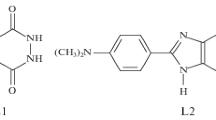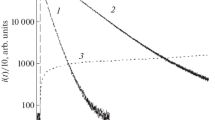Abstract
We studied the effect of cumene hydroperoxide, t-butyl hydroperoxide, and hydrogen peroxide on intact healthy human erytyrocytes (15 g hemoglobin/dl) using chemiluminescence to monitor peroxidation. We measured the chemiluminescence spectrum, the process of hemolysis, the pH shift, and absorbance spectrum during the incubation with chemicals producing oxidative stress. Maximum chemiluminescence was reached with cumene hydroperoxide at about 50 min, but with t-butyl hydroperoxide at 100 min. The effect of organic hydroperoxide was concentration dependent, whereas the effect of hydrogen peroxide was independent of concentration. Peroxides induced hemolysis after 30 min. The pH shift to alkaline was observed in the first 20-min period. Incubation with organic hydroperoxides induced a decrease in absorption at 580, 545, and 345 nm. Hydrogen peroxide induced a decrease in the same period of time but this returned to the normal range by 120 min. There was no change in absorption at 420 nm with any of the peroxidative agents. Our results suggest that low-level chemiluminescence is a useful model for studying hydroperoxide-induced peroxidation in human erythrocytes.
Similar content being viewed by others
References
Chiu D, Kuypers F, Lubin B. Lipid peroxidation in human red cells. Semin Hematol 1989;26:257.
Clemens MR, Waller HD. Lipid peroxidation in erythrocytes. Chem Phys Lipids 1987;45:251.
Saltman P. Oxidative stress: a radical view. Semin Hematol 1989;26:249.
Gutteridge JMC, Halliwell B. The measurement and mechanism of lipid peroxidation in biological systems. Trends Biochem Sci 1990;15:129.
Murphy ME, Sies H (1990) Visible-range low-level chemiluminescence in biological systems. Methods in Enzymol 186:595
Cadenas E, Sies H. Low-level chemiluminescence as an indicator of singlet molecular oxygen in biological systems. Methods Enzymol 1984;105:221.
Burk RF, Ludden TM. Exhales alkanes as indices of in vivo lipid peroxidation. Biochem Pharmacol 1989;38:1029.
Yalçin AS, Sabuncu N, Emerk K. Cumene hydroperoxide-induced chemiluminecence in human erythrocytes: effect of antioxidants and sulphydryl compounds. Int J Biochem 1992; 24:499.
Marnett LJ. Peroxyl free radicals: biological reactive intermediates produced during lipid peroxidation. Adv Exp Med Biol 1991;283:65.
Yalçin AS, Sabuncu N, Emerk K. Chemiluminescence measurements as an indicator of cumene hydroperoxide-induced lipid peroxidation in human erythrocytes. Hematol Rev 1990;4:147.
Smith JA, Baker MS, Weidemann MJ. Free radical generation in hydroperoxide-treated erythrocytes monitored continuously by luminol-amplified chemiluminescence. Biochem Int 1992; 28:1009.
Author information
Authors and Affiliations
Rights and permissions
About this article
Cite this article
Yeşilkaya, A., Yeĝin, A., Yücel, G. et al. Continuous monitoring of hydroperoxide-induced peroxidation in human erythrocytes by low-level chemiluminescence. Int J Clin Lab Res 26, 60–68 (1996). https://doi.org/10.1007/BF02644778
Received:
Accepted:
Issue Date:
DOI: https://doi.org/10.1007/BF02644778




